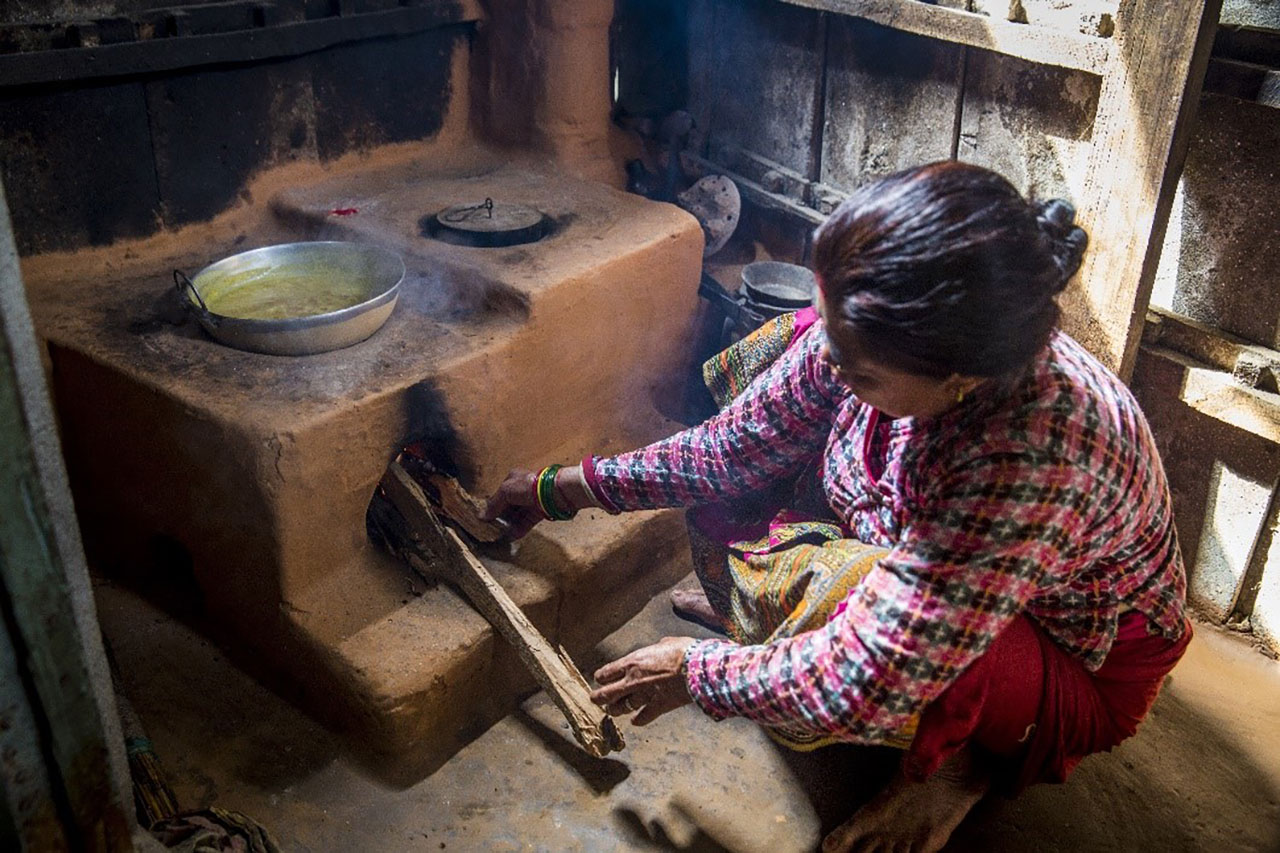This site uses cookies, as explained in our terms of use. If you consent, please close this message and continue to use this site.
 Tasked with household duties, women are more exposed to indoor smoke during cooking, making them particularly vulnerable to respiratory diseases. (Photo: Jitendra Bajracharya/ICIMOD)
Tasked with household duties, women are more exposed to indoor smoke during cooking, making them particularly vulnerable to respiratory diseases. (Photo: Jitendra Bajracharya/ICIMOD)
In Nepal, women are predominantly the designated household managers. Among an array of chores, rural women are also primarily responsible for firewood collection – a taxing, time-consuming activity with detrimental effects on health. A study conducted by ICIMOD in 2015 in Ratnagiri, Chitwan, has shown that until the use of firewood in kitchens is completely eliminated, women will not be free from the drudgery of fuelwood collection and by extension will continue to be shackled by household duties and exposed to injurious indoor smoke. This finding was based on the examination of different types of fuel users, including users who exclusively use clean energy, those who exclusively use unclean fuel, and those who use a mix of energy sources.
The physical activity of collecting fuelwood in rural settings, without access to clean cooking technologies and alternative energy sources, takes a toll on women. Studies have shown that in South Asia, women are forced to spend up to 20 hours or more per week collecting fuelwood (Practical Action, 2014), hauling up to 20 kg during a trip over long distances (FAO, 1997). This compounds women’s physical and psychological stress. They consequently look to share their household chores, and the burden – including the onerous task of fuelwood collection – usually shifts to girls in the household. School dropout rates among girls are high in South Asia.
Adding to the drudgery, women in rural Nepal also work in kitchens with poor ventilation and lighting and open fires, which have injurious effects on health. More than 23,000 deaths in the country each year are attributable to indoor air pollution emanating from poor kitchen setups (WHO, 2016). And the health impacts are quite discriminatory; women, children, and the elderly – who spend more time in households exposed to the pollution – are disproportionately affected by ailments such as bronchitis, asthma, wheezing, cough, and chronic obstructive pulmonary disease. A study conducted in Nepal found a strong relationship between the maternally reported number of hours per day children under two years stayed by the fire and the incidence of moderate to severe acute respiratory infection. Incidences of this infection decreased by 25% in cases where children were exposed to smoke for shorter periods (Pandey et al. 1989). Another study by Pandey, Basnyat, and Neupane (1988) found that women in Nepal exposed to indoor air pollution for longer hours have high rates of prevalence of bronchitis similar to men who smoke, despite being non-smokers or smoking less than the men.
Energy stacking – spreading the use of different sources of energy through the day – is a common practice in most households in Nepal. The women in Ratnagiri also use a combination of different energy sources through the day, such as biomass, biogas, liquefied petroleum gas (LPG), and electricity. Among these, biomass is a primary fuel source, accounting for around 80% of total residential energy consumption. The Ratnagiri study determined that biomass use patterns also differ from season to season: higher during the winter for cooking and space heating and accordingly lower in summer and monsoon. Biogas and LPG use increase during monsoon and summer since biomass collection is difficult and fuelwood takes longer to burn.
Clean energy sources such as LPG and electricity are perceived to be expensive in comparison to freely available fuelwood. In Nepal, clean cooking promotion initiatives have largely focused on promoting biomass stoves. Beginning in the 1950s, such initiatives have distributed 700,000 improved cook stoves in 63 districts. However, the ICIMOD study references several studies that have shown that most improved biomass stoves perform poorly outside lab conditions and are unable to achieve WHO-recommended indoor air quality standards. Moreover, although it is claimed that biomass-powered stoves reduce the use of biomass, they still create a dependency on local resources. This leads to continued extraction from local forests, leading to negative impacts on the environment and continued drudgery for women.
Nepal’s Biomass Energy Strategy 2017 aims to make the country’s kitchens smokeless by 2022. In the short and medium term, the strategy focuses on biomass use. In the longer run, it advocates electricity as an alternative to biomass. With increasing hydropower capacity, this could possibly help the country’s kitchens wean off biomass dependence.
The Government of Nepal has already issued a white paper in 2018 titled “One electric stove in every home”, aiming to increase the use of electricity for cooking in Nepali households. With proper policy and planning, both urban and rural households could shift to clean cooking powered by electricity produced domestically, thereby significantly reducing import costs on LPG. The government should prioritize energy sources that can ensure national energy security through domestically available resources. This would lift the weight of drudgery from women’s shoulders, considerably reduce their health problems, and allow them to engage in more productive work.